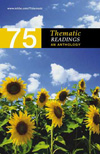
Elizabeth Cady Stanton |  |
Elizabeth Cady StantonElizabeth Cady Stanton, "Declaration of Sentiments" Elizabeth Cady Stanton (1815-1902) was born in Johnstown, New York and
attended Emma Willard's Troy Female Seminary. She was a pioneering women's
rights leader, a powerful orator, and a writer. Stanton was also the editor
of the national feminist newspaper Revolution, a contemporary of
Susan B. Anthony, and president of the National Women's Suffrage Association
from 1869 to 1890. Her books include Suffrage, A Natural Right
(1894), The Woman's Bible (1895-1898, 2 volumes), and Eighty
Years and More (1815-1897): Reminiscences of Elizabeth Cady Stanton
(1898). She and Anthony can reasonably be said to have started the women's
movement in the U.S. "Declaration of Sentiments" was delivered
at the Seneca Falls Conference in 1848 and was first published in 1870
as the Address of Mrs. Elizabeth Cady Stanton: Delivered at Seneca
Falls & Rochester, N.Y., July 19th & August 2d, 1848. | QUESTIONS FOR DISCUSSION | CONTENT - How does the author view married women?
- What does the author mean by the phrase "a different code
of morals for men and women"?
- How does the author see the future as she goes about her main task?
- What is Stanton asking the U.S. government to do here?
- Summarize Stanton's grievances "on the part of man toward
woman."
STRATEGY AND STYLE - You've seen the first twelve words (and a few more, sprinkled throughout)
of this speech somewhere before, verbatim. Where was it and what is
the effect of the comparison the author is drawing here? Discuss this
usage as an effective or ineffective introduction.
- A syllogism is a three-part argument that contains a major premise,
a minor premise, and a conclusion. Here's an example: major premise—All
cats need water; minor premise—Gus is a cat; conclusion—Gus needs water.
Find and explain the syllogism in this piece.
- What audience did Stanton have in mind for this speech? Where in
the document can you point to support your answer? How has the nature
of this audience changed over time?
- The words He has are repeated at the beginning of most of
the paragraphs from paragraph four through paragraph eighteen. What
is the effect of this repetition in light of the author's view of sexual
politics?
| ENGAGING THE TEXT | - Do you consider yourself a feminist? Do you believe men can be
feminists? Explain. How might have the answers to these questions affected
your position regarding this piece?
- How did you picture Stanton as you read her speech? What relationship
did this mental image have with your experience of reading it? (By the
way, many of the links below will take you to pages with photos of this
author.)
| SUGGESTIONS FOR SUSTAINED WRITING | - Read or review "The Declaration of Independence." Write
a comparison/contrast essay about it and "Declaration of Sentiments."
- How far have the Women's Rights Movement and feminism come since
1848, when this speech was first delivered? What needs still have to
be addressed? Explain.
| FOR FURTHER RESEARCH | Do some research about the 1848 Seneca Falls Conference. (Many of the
links below will help get you started.) Besides Stanton, who were some
of the other speakers there? How well attended was the event? What were
people wearing? How was it received in the press? How did your research
add some color to your reading? | WEB CONNECTION | Did you know that Ken Burns and Paul Barnes made a documentary for PBS
called Not for Ourselves Alone: The Story of Elizabeth Cady Stanton
and Susan B. Anthony? Take a look at the homepage
for the film, which has photos, a quote, and lots of links. | LINKS | Biographical Here's a hyperlinked biography
of Stanton, with a photo album, from the National Park Service. Looking for a bit of a personal touch? The homepage
for the Stanton and Anthony Papers Project Online has reproductions
of the two women's autographs and a couple photos.
Bibliographical Here is Stanton's speech "Solitude
of Self," which she gave before the U.S. Senate Committee on
Woman Suffrage in 1892. How can you compare this speech to the one that's
in your text? Eighty Years and More is the title of a memoir by Stanton.
Click here
and you'll find the whole thing in etext. Do you like using etext? Does
it have any advantages over plain old hard copy?
Cultural Stanton was a key figure in what's sometimes called the "first
wave" of feminism. Would you like some information that will help
you put this movement into a historical context? This collection
of links from Northern Arizona University will help you do just
that. Interested in doing a paper about the history of women's suffrage
in the U.S.? This hyperlinked introduction
to the subject is a great place to start your research. How about taking a look at the 1848 Seneca Falls Convention in
more detail? This page
from the American Treasures part of the Library of Congress online has
a brief history, some photos, and related links.
|
|
|
|